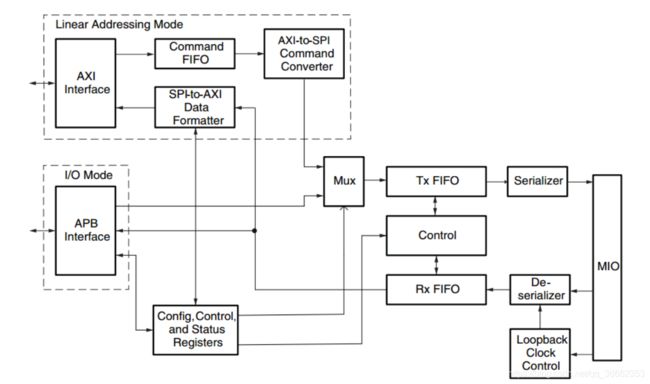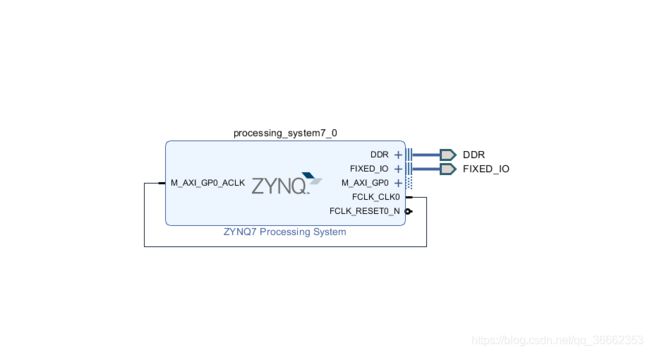ZYNQ学习之旅--PS_QSPI读写flash
目录标题
- 简介
- BD设计
- 软件设计
简介
ZYNQ 中的 QSPI Flash 控制器可以工作在三种模式下:I/O 模式、线性地址模式,以及传统 SPI 模式。
在 I/O 模式中,软件负责实现 Flash 器件的通信协议。软件需要将 Flash 命令和数据写到控制器中的 TXD
寄存器中,然后将接收到的数据从 RXD 寄存器中读出。而线性地址模式则使用一组器件操作来减小软件从 Flash 中读取数据的开销。线性模式使用硬件来实现来自 AXI 接口的命令到 Flash 指令的转换。对用户来说,在线性模式下读 QSPI Flash 就像读取 ROM 一样简单。但是该模式只支持读操作,不支持写操作。传统模式下的 QSPI Flash 控制器就像一个普通的 SPI 控制器,这个模式用的相对较少。
QSPI Flash 控制器的系统框图如下所示:

从图中可以看到,QSPI Flash 控制器通过 MIO 与外部 Flash 器件连接,支持三种模式:单个从器
件模式、双从器件并行模式和双从器件堆模式。通过使用双从器件模式可以扩展 QSPI Flash 的存储容量。在使用单个器件的时候,直接存储访问 Flash 器件的地址映射 FC00_0000 到FCFF_FFFF(16MB)。在使用双器件模式时,地址空间可以扩展为 FC00_0000 至 FDFF_FFFF(32MB)。另外,在上图中可以看到控制器左侧有两种类型的接口:AXI 接口和 APB 接口。其中 AXI 接口用于线性地址模式,而 APB 接口用于 I/O 模式。QSPI Flash 控制器的模块示意图如图所示。从中我们可以清晰的看出 QSPI Flash 控制器两种模式的差异。由于线性地址模式不支持写操作,因此本次实验重点介绍 I/O 模式。在 I/O 模式下,软件需要把命令和数据转化成 QSPI Flash 协议下的指令,转换之后的指令将被写入 TxFIFO。然后发送逻辑将 Tx FIFO 中的内容按照 QSPI 接口规范进行并串转换,最后通过 MIO 将转换后的数据送到 Flash 存储器中。在发送逻辑将 Tx FIFO 中的数据发送出去的同时,接收逻辑会采样所发送的串行数据,进行串并转换后存储到 Rx FIFO 里面。如果执行的是读操作,在发送读指令和读地址之后,MIO 会在发送逻辑的控制下由输出模式切换成输入模式,从Flash 中读出的数据将被存储丰 Rx FIFO 中。由于 Rx FIFO 中会同时接收由软件发出的指令,因此我们需要对 Rx FIFO 中的原始数据进行过滤,从而得到从 Flash 中读出的有效数据。

BD设计
软件设计
#include "xparameters.h" /* SDK generated parameters */
#include "xqspips.h" /* QSPI device driver */
#include "xil_printf.h"
/************************** Constant Definitions *****************************/
/*
* The following constants map to the XPAR parameters created in the
* xparameters.h file. They are defined here such that a user can easily
* change all the needed parameters in one place.
*/
#define QSPI_DEVICE_ID XPAR_XQSPIPS_0_DEVICE_ID
/*
* The following constants define the commands which may be sent to the FLASH
* device.
*/
#define WRITE_STATUS_CMD 0x01
#define WRITE_CMD 0x02
#define READ_CMD 0x03
#define WRITE_DISABLE_CMD 0x04
#define READ_STATUS_CMD 0x05
#define WRITE_ENABLE_CMD 0x06
#define FAST_READ_CMD 0x0B
#define DUAL_READ_CMD 0x3B
#define QUAD_READ_CMD 0x6B
#define BULK_ERASE_CMD 0xC7
#define SEC_ERASE_CMD 0xD8
#define READ_ID 0x9F
/*
* The following constants define the offsets within a FlashBuffer data
* type for each kind of data. Note that the read data offset is not the
* same as the write data because the QSPI driver is designed to allow full
* duplex transfers such that the number of bytes received is the number
* sent and received.
*/
#define COMMAND_OFFSET 0 /* FLASH instruction */
#define ADDRESS_1_OFFSET 1 /* MSB byte of address to read or write */
#define ADDRESS_2_OFFSET 2 /* Middle byte of address to read or write */
#define ADDRESS_3_OFFSET 3 /* LSB byte of address to read or write */
#define DATA_OFFSET 4 /* Start of Data for Read/Write */
#define DUMMY_OFFSET 4 /* Dummy byte offset for fast, dual and quad
reads */
#define DUMMY_SIZE 1 /* Number of dummy bytes for fast, dual and
quad reads */
#define RD_ID_SIZE 4 /* Read ID command + 3 bytes ID response */
#define BULK_ERASE_SIZE 1 /* Bulk Erase command size */
#define SEC_ERASE_SIZE 4 /* Sector Erase command + Sector address */
/*
* The following constants specify the extra bytes which are sent to the
* FLASH on the QSPI interface, that are not data, but control information
* which includes the command and address
*/
#define OVERHEAD_SIZE 4
/*
* The following constants specify the page size, sector size, and number of
* pages and sectors for the FLASH. The page size specifies a max number of
* bytes that can be written to the FLASH with a single transfer.
*/
#define SECTOR_SIZE 0x10000
#define NUM_SECTORS 0x100
#define NUM_PAGES 0x10000
#define PAGE_SIZE 256
/*
* Number of flash pages to be written.
*/
#define PAGE_COUNT 900
/*
* Flash address to which data is ot be written.
*/
#define TEST_ADDRESS 0x00005000
#define UNIQUE_VALUE 0x05
/*
* The following constants specify the max amount of data and the size of the
* the buffer required to hold the data and overhead to transfer the data to
* and from the FLASH.
*/
#define MAX_DATA PAGE_COUNT * PAGE_SIZE
/**************************** Type Definitions *******************************/
/***************** Macros (Inline Functions) Definitions *********************/
/************************** Function Prototypes ******************************/
void FlashErase(XQspiPs *QspiPtr, u32 Address, u32 ByteCount);
void FlashWrite(XQspiPs *QspiPtr, u32 Address, u32 ByteCount, u8 Command);
void FlashRead(XQspiPs *QspiPtr, u32 Address, u32 ByteCount, u8 Command);
int FlashReadID(void);
int QspiFlashPolledExample(XQspiPs *QspiInstancePtr, u16 QspiDeviceId);
/************************** Variable Definitions *****************************/
/*
* The instances to support the device drivers are global such that they
* are initialized to zero each time the program runs. They could be local
* but should at least be static so they are zeroed.
*/
static XQspiPs QspiInstance;
/*
* The following variable allows a test value to be added to the values that
* are written to the FLASH such that unique values can be generated to
* guarantee the writes to the FLASH were successful
*/
int Test = 5;
/*
* The following variables are used to read and write to the flash and they
* are global to avoid having large buffers on the stack
*/
u8 ReadBuffer[MAX_DATA + DATA_OFFSET + DUMMY_SIZE];
u8 WriteBuffer[PAGE_SIZE + DATA_OFFSET];
/*****************************************************************************/
/**
*
* Main function to call the QSPI Flash example.
*
* @param None
*
* @return XST_SUCCESS if successful, otherwise XST_FAILURE.
*
* @note None
*
******************************************************************************/
int main(void)
{
int Status;
xil_printf("QSPI FLASH Polled Example Test \r\n");
/*
* Run the Qspi Interrupt example.
*/
Status = QspiFlashPolledExample(&QspiInstance, QSPI_DEVICE_ID);
if (Status != XST_SUCCESS) {
xil_printf("QSPI FLASH Polled Example Test Failed\r\n");
return XST_FAILURE;
}
xil_printf("Successfully ran QSPI FLASH Polled Example Test\r\n");
return XST_SUCCESS;
}
/*****************************************************************************/
/**
*
* The purpose of this function is to illustrate how to use the XQspiPs
* device driver in polled mode. This function writes and reads data
* from a serial FLASH.
*
* @param None.
*
* @return XST_SUCCESS if successful, else XST_FAILURE.
*
* @note None.
*
*****************************************************************************/
int QspiFlashPolledExample(XQspiPs *QspiInstancePtr, u16 QspiDeviceId)
{
int Status;
u8 *BufferPtr;
u8 UniqueValue;
int Count;
int Page;
XQspiPs_Config *QspiConfig;
/*
* Initialize the QSPI driver so that it's ready to use
*/
QspiConfig = XQspiPs_LookupConfig(QspiDeviceId);
if (NULL == QspiConfig) {
return XST_FAILURE;
}
Status = XQspiPs_CfgInitialize(QspiInstancePtr, QspiConfig,
QspiConfig->BaseAddress);
if (Status != XST_SUCCESS) {
return XST_FAILURE;
}
/*
* Perform a self-test to check hardware build
*/
Status = XQspiPs_SelfTest(QspiInstancePtr);
if (Status != XST_SUCCESS) {
return XST_FAILURE;
}
/*
* Initialize the write buffer for a pattern to write to the FLASH
* and the read buffer to zero so it can be verified after the read,
* the test value that is added to the unique value allows the value
* to be changed in a debug environment to guarantee
*/
for (UniqueValue = UNIQUE_VALUE, Count = 0; Count < PAGE_SIZE;
Count++, UniqueValue++) {
WriteBuffer[DATA_OFFSET + Count] = (u8)(UniqueValue + Test);
}
memset(ReadBuffer, 0x00, sizeof(ReadBuffer));
/*
* Set Manual Start and Manual Chip select options and drive HOLD_B
* pin high.
*/
XQspiPs_SetOptions(QspiInstancePtr, XQSPIPS_MANUAL_START_OPTION |
XQSPIPS_FORCE_SSELECT_OPTION |
XQSPIPS_HOLD_B_DRIVE_OPTION);
/*
* Set the prescaler for QSPI clock
*/
XQspiPs_SetClkPrescaler(QspiInstancePtr, XQSPIPS_CLK_PRESCALE_8);
/*
* Assert the FLASH chip select.
*/
XQspiPs_SetSlaveSelect(QspiInstancePtr);
FlashReadID();
/*
* Erase the flash.
*/
FlashErase(QspiInstancePtr, TEST_ADDRESS, MAX_DATA);
/*
* Write the data in the write buffer to the serial FLASH a page at a
* time, starting from TEST_ADDRESS
*/
for (Page = 0; Page < PAGE_COUNT; Page++) {
FlashWrite(QspiInstancePtr, (Page * PAGE_SIZE) + TEST_ADDRESS,
PAGE_SIZE, WRITE_CMD);
}
/*
* Read the contents of the FLASH from TEST_ADDRESS, using Normal Read
* command. Change the prescaler as the READ command operates at a
* lower frequency.
*/
FlashRead(QspiInstancePtr, TEST_ADDRESS, MAX_DATA, READ_CMD);
/*
* Setup a pointer to the start of the data that was read into the read
* buffer and verify the data read is the data that was written
*/
BufferPtr = &ReadBuffer[DATA_OFFSET];
for (UniqueValue = UNIQUE_VALUE, Count = 0; Count < MAX_DATA;
Count++, UniqueValue++) {
if (BufferPtr[Count] != (u8)(UniqueValue + Test)) {
return XST_FAILURE;
}
}
/*
* Read the contents of the FLASH from TEST_ADDRESS, using Fast Read
* command
*/
memset(ReadBuffer, 0x00, sizeof(ReadBuffer));
FlashRead(QspiInstancePtr, TEST_ADDRESS, MAX_DATA, FAST_READ_CMD);
/*
* Setup a pointer to the start of the data that was read into the read
* buffer and verify the data read is the data that was written
*/
BufferPtr = &ReadBuffer[DATA_OFFSET + DUMMY_SIZE];
for (UniqueValue = UNIQUE_VALUE, Count = 0; Count < MAX_DATA;
Count++, UniqueValue++) {
if (BufferPtr[Count] != (u8)(UniqueValue + Test)) {
return XST_FAILURE;
}
}
/*
* Read the contents of the FLASH from TEST_ADDRESS, using Dual Read
* command
*/
memset(ReadBuffer, 0x00, sizeof(ReadBuffer));
FlashRead(QspiInstancePtr, TEST_ADDRESS, MAX_DATA, DUAL_READ_CMD);
/*
* Setup a pointer to the start of the data that was read into the read
* buffer and verify the data read is the data that was written
*/
BufferPtr = &ReadBuffer[DATA_OFFSET + DUMMY_SIZE];
for (UniqueValue = UNIQUE_VALUE, Count = 0; Count < MAX_DATA;
Count++, UniqueValue++) {
xil_printf("0x%x\n",BufferPtr[Count]);
if (BufferPtr[Count] != (u8)(UniqueValue + Test)) {
return XST_FAILURE;
}
}
/*
* Read the contents of the FLASH from TEST_ADDRESS, using Quad Read
* command
*/
memset(ReadBuffer, 0x00, sizeof(ReadBuffer));
FlashRead(QspiInstancePtr, TEST_ADDRESS, MAX_DATA, QUAD_READ_CMD);
/*
* Setup a pointer to the start of the data that was read into the read
* buffer and verify the data read is the data that was written
*/
BufferPtr = &ReadBuffer[DATA_OFFSET + DUMMY_SIZE];
for (UniqueValue = UNIQUE_VALUE, Count = 0; Count < MAX_DATA;
Count++, UniqueValue++) {
if (BufferPtr[Count] != (u8)(UniqueValue + Test)) {
return XST_FAILURE;
}
}
/*
* Initialize the write buffer for a pattern to write to the FLASH
* and the read buffer to zero so it can be verified after the read,
* the test value that is added to the unique value allows the value
* to be changed in a debug environment to guarantee
*/
for (UniqueValue = UNIQUE_VALUE, Count = 0; Count < PAGE_SIZE;
Count++, UniqueValue++) {
WriteBuffer[DATA_OFFSET + Count] = (u8)(UniqueValue + Test);
}
memset(ReadBuffer, 0x00, sizeof(ReadBuffer));
/*
* Set Auto Start and Manual Chip select options and drive HOLD_B
* pin high.
*/
XQspiPs_SetOptions(QspiInstancePtr, XQSPIPS_FORCE_SSELECT_OPTION |
XQSPIPS_HOLD_B_DRIVE_OPTION);
/*
* Erase the flash.
*/
FlashErase(QspiInstancePtr, TEST_ADDRESS, MAX_DATA);
/*
* Write the data in the write buffer to the serial FLASH a page at a
* time, starting from TEST_ADDRESS
*/
for (Page = 0; Page < PAGE_COUNT; Page++) {
FlashWrite(QspiInstancePtr, (Page * PAGE_SIZE) + TEST_ADDRESS,
PAGE_SIZE, WRITE_CMD);
}
/*
* Read the contents of the FLASH from TEST_ADDRESS, using Normal Read
* command. Change the prescaler as the READ command operates at a
* lower frequency.
*/
FlashRead(QspiInstancePtr, TEST_ADDRESS, MAX_DATA, READ_CMD);
/*
* Setup a pointer to the start of the data that was read into the read
* buffer and verify the data read is the data that was written
*/
BufferPtr = &ReadBuffer[DATA_OFFSET];
for (UniqueValue = UNIQUE_VALUE, Count = 0; Count < MAX_DATA;
Count++, UniqueValue++) {
if (BufferPtr[Count] != (u8)(UniqueValue + Test)) {
return XST_FAILURE;
}
}
/*
* Read the contents of the FLASH from TEST_ADDRESS, using Fast Read
* command
*/
memset(ReadBuffer, 0x00, sizeof(ReadBuffer));
FlashRead(QspiInstancePtr, TEST_ADDRESS, MAX_DATA, FAST_READ_CMD);
/*
* Setup a pointer to the start of the data that was read into the read
* buffer and verify the data read is the data that was written
*/
BufferPtr = &ReadBuffer[DATA_OFFSET + DUMMY_SIZE];
for (UniqueValue = UNIQUE_VALUE, Count = 0; Count < MAX_DATA;
Count++, UniqueValue++) {
if (BufferPtr[Count] != (u8)(UniqueValue + Test)) {
return XST_FAILURE;
}
}
/*
* Read the contents of the FLASH from TEST_ADDRESS, using Dual Read
* command
*/
memset(ReadBuffer, 0x00, sizeof(ReadBuffer));
FlashRead(QspiInstancePtr, TEST_ADDRESS, MAX_DATA, DUAL_READ_CMD);
/*
* Setup a pointer to the start of the data that was read into the read
* buffer and verify the data read is the data that was written
*/
BufferPtr = &ReadBuffer[DATA_OFFSET + DUMMY_SIZE];
for (UniqueValue = UNIQUE_VALUE, Count = 0; Count < MAX_DATA;
Count++, UniqueValue++) {
if (BufferPtr[Count] != (u8)(UniqueValue + Test)) {
return XST_FAILURE;
}
}
/*
* Read the contents of the FLASH from TEST_ADDRESS, using Quad Read
* command
*/
memset(ReadBuffer, 0x00, sizeof(ReadBuffer));
FlashRead(QspiInstancePtr, TEST_ADDRESS, MAX_DATA, QUAD_READ_CMD);
/*
* Setup a pointer to the start of the data that was read into the read
* buffer and verify the data read is the data that was written
*/
BufferPtr = &ReadBuffer[DATA_OFFSET + DUMMY_SIZE];
for (UniqueValue = UNIQUE_VALUE, Count = 0; Count < MAX_DATA;
Count++, UniqueValue++) {
if (BufferPtr[Count] != (u8)(UniqueValue + Test)) {
return XST_FAILURE;
}
}
return XST_SUCCESS;
}
